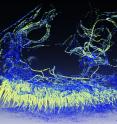Unraveling the light of fireflies
Fireflies used rapid light flashes to communicate. This "bioluminescence" is an intriguing phenomenon that has many potential applications, from drug testing and monitoring water contamination, and even lighting up streets using glow-in-dark trees and plants. Fireflies emit light when a compound called luciferin breaks down. We know that this reaction needs oxygen, but what we don't know is how fireflies actually supply oxygen to their light-emitting cells. Using state-of-the-art imaging techniques, scientists from Switzerland and Taiwan have determined how fireflies control oxygen distribution to light up their cells. The work is published in Physical Review Letters.
The firefly's light-producing organ is called the "lantern," and it is located in the insect's abdomen. It looks like a series of tubes progressing into smaller ones and so one, like a tree's branches growing into twigs. The function of these tubes, called, is to supply oxygen to the cells of the lantern, which contain luciferase and can produce light. However, the complexity of the firefly's lantern has made it difficult to study this mechanism in depth, and reproduce it for technological applications.
Giorgio Margaritondo at EPFL, Yeukuang Hwu at the Academia Sinica and their colleagues at the National Tsing Hua University in Taiwan have successfully used two sophisticated imaging techniques to overcome the complexity of the firefly lantern and map out how oxygen is supplied to light-emitting cells. The techniques are called synchrotron phase contrast microtomography and transmission x-ray microscopy. They can scan down to the level of a single cell, even allowing researchers to look inside it.
By applying these techniques on live fireflies, the scientists were able to see the entire structure of the lantern for the first time, and to also make quantitative evaluations of oxygen distribution.
The imaging showed that the firefly diverts oxygen from other cellular functions and puts it into the reaction that breaks up luciferin. Specifically, the researchers found that oxygen consumption in the cell decreased, slowing down energy production. At the same time, oxygen supply switched to light-emission.
The study is the first to ever show the firefly's lantern in such detail, while also providing clear evidence that it is optimized for light emission thanks to the state-of-the-art techniques used by the scientists. But Margaritondo points out another innovation: "The techniques we used have an advantage over, say, conventional x-ray techniques, which cannot easily distinguish between soft tissues. By using an approach based on changes in light intensity (phase-contrast) as opposed to light absorption (x-rays), we were able to achieve high-resolution imaging of the delicate firefly lantern."
Source: Ecole Polytechnique Fédérale de Lausanne
Other sources
- Unraveling the light of firefliesfrom Science DailyWed, 17 Dec 2014, 22:32:01 UTC
- Unraveling the light of firefliesfrom PhysorgWed, 17 Dec 2014, 9:00:19 UTC
